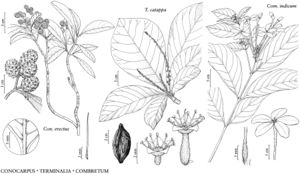Terminalia
Syst. Nat. ed. 12, 2: 665, 674. 1767. name conserved
| Taxon | Illustrator ⠉ | |
|---|---|---|
 | Conocarpus erectus Terminalia catappa Combretum indicum |
Trees or shrubs, with Terminalia branching (branches in tiers, borne on central trunk, main axis erect and monopodial, lateral branches horizontal and sympodial), without pneumatophores. Stems erect and horizontal with leaves clustered at ends of erect, short-shoots, separated by longer, ± bare stem segments. Leaves persistent or tardily deciduous (plants then briefly leafless), alternate and spiral; stipules present, appearing as fingerlike, multicellular, glandular-hairs at petiole base; petiole not differentiated proximally and no part of it persistent, nectar glands absent [sometimes with sessile glands], sessile glands sometimes present at blade base; blade papery to leathery, venation brochidodromous [nearly eucamptodromous], apex acuminate, acute, mucronate, obtuse, retuse, or rounded; with or without hair-tuft or pit [pocket] domatia abaxially, at junction of secondary and tertiary-veins with midvein, or junction of tertiary with secondary-veins, sometimes also at other vein junctions, without glands. Inflorescences axillary, spikes, usually clustered on branches distally; bracteoles absent. Flowers somewhat conspicuous [inconspicuous], bisexual or bisexual and staminate on same plant, with staminate flowers distal [proximal] on spikes (or mixed with bisexual flowers); hypanthium cupulate, free portion 1–2 mm, from constriction at apex of ovary, pubescent abaxially throughout or pubescent proximally and glabrous distally [glabrous throughout]; sepals 4 or 5, pale green, yellow, or white, sometimes red-tinged, triangular to ovate-triangular, glabrous abaxially or pubescent; petals 0; stamens [4–] 8–10, exserted; nectary disc lobate, atop ovary, pubescent; ovary terete, straight to slightly curved; style ± straight, free from hypanthium, pistillode absent in staminate flowers; ovules 2 or 3. Drupes radially symmetric in cross-section to slightly [strongly] flattened, ovoid to ellipsoid; with 2 poorly developed ridges, 2 well-developed ridges or wings [2–5 well-developed wings], or 5 poorly developed and rounded lobes [terete and without lobes or wings]; hypanthium and calyx persistent or deciduous.
Distribution
Florida, nearly worldwide in pantropics
Discussion
Species ca. 200 (4 in the flora).
The flowers, with their exposed nectar glands, attract a variety of insects. Terminalia has a distinctive branching pattern, in which the main axis is erect and monopodial and the lateral branches are horizontal and sympodial. On the lateral branches, each segment originates as a lateral branch within the terminal leaf cluster of the previous segment. At first, each lateral branch grows horizontally, but eventually its apex becomes erect as a short shoot, producing a new terminal leaf cluster. Each sympodium as a whole branches where two lateral shoots continue its growth, substituting for the erect, terminal short shoot.
Terminaliabuceras and T. molinetii often have been placed in Bucida, a genus traditionally separated from Terminalia by the retention of the free portion of the hypanthium and calyx on the fruit. The calyx is more or less deciduous in T. molinetii and it is persistent in three species of Madagascar and two of the Solomon Islands, which are phenetically quite different and likely not closely related to T. buceras or T. molinetii, calling this generic distinction into question (C. A. Stace 2007, 2010). A DNA-based phylogenetic analysis (O. Maurin et al. 2010) indicated that the recognition of Bucida renders Terminalia non-monophyletic. Bucida, therefore, has been placed in the synonymy of Terminalia (Stace 2007, 2010) as sect. Bucida (Linnaeus) Alwan & Stace.
Selected References
None.
Key
| 1 | Flowers bisexual and staminate; spikes with numerous staminate flowers distally; drupes slightly flattened, with 2 poorly developed and rounded ridges, or 2 well-developed ridges or wings; hypanthia usually deciduous in age; leaf blades usually with pit- or hair-tuft domatia, also with nectar glands (near base). | > 2 |
| 2 | Drupes 35–70 mm, with 2 well-developed ridges or wings; leaf blades 6–35 cm, with pit-domatia. | Terminalia catappa |
| 2 | Drupes 12–20 mm, with 2 poorly developed and rounded ridges; leaf blades 4.2–19.5 cm, usually with hair-tuft domatia. | Terminalia muelleri |
| 1 | Flowers bisexual; spikes with bisexual flowers distributed evenly or clustered distally; drupes radially symmetric in cross section, with 5 poorly developed and rounded lobes; hypanthia ± persistent or deciduous in age; leaf blades without domatia and nectar glands. | > 3 |
| 3 | Leaf blades 2–11 cm; branches without thorns in mature plants, with stout thorns in juvenile plants; spikes with flowers distributed along 1–6 cm; drupes (4–)5–8 mm. | Terminalia buceras |
| 3 | Leaf blades 0.4–2.8(–3.5) cm; branches with slender thorns; spikes with flowers clustered in distal 0.2–1 cm; drupes 3–6 mm. | Terminalia molinetii |